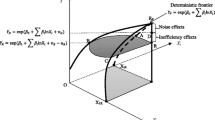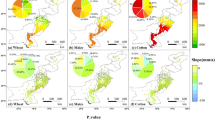Abstract
Xinjiang’s agriculture is a typical irrigated agriculture for its agriculture water consumption accounts for 96% of the total water use. As a typical resource-deficient area, the key to Xinjiang’s agricultural development is saving water. This paper takes the high-efficient water-saving irrigation technology of 41 regions along the Tarim River from 2002 to 2013 as the research object, adopts spatial stochastic frontier model to measure the space efficiency of high-efficient water-saving irrigation technology, and analyzes the effect of water-saving irrigation technology on agricultural development. Results show that the water-saving irrigation technology has a spatial effect, if neglecting it, the error of missing variables will occur, and the average loss will be 6.98 percentage points. The spatial correlation effect promotes the improvement of the efficiency of water-saving irrigation technology. The spatial heterogeneity leads to the spatial imbalance of the efficiency of water-saving irrigation technology. The promotion of agricultural water-saving irrigation technology can increase production and the efficiency of agricultural development. Due to the technical heterogeneity of different types of water-saving irrigation technology, the contribution to the development of agriculture is also different. The study finds that water-saving irrigation technology of drip irrigation in the Tarim River contributes more to agricultural development.
Similar content being viewed by others
References
Neumann K, Verburg P, Stehfest E, et al., The yield gap of global grain production: A spatial analysis, Agricultural Systems, 2010, 103(5): 316–326.
Berbel J, Gutiérrez-Martín C, Rodríguez-Díaz J A, et al., Literature review on rebound effect of water saving measures and analysis of a spanish case study, Water Resources Management, 2015, 29(3): 663–678.
Ahmadi S H, Agharezaee M, Kamgar-Haghighi A A, et al., Water-saving irrigation strategies affect tuber water relations and nitrogen content of potatoes, International Journal of Plant Production, 2016, 10(3): 275–288.
Xu T, Yao L Y, Qiao D, et al., Eco-efficiency assessment of water-saving irrigation technology, Resources Science, 2016, 38(10): 1925–1934.
Lu J, Jin X, and Han X Y, Economic and technical evaluation of farmers adopting water-saving irrigation-taking maize production in Tongliao city as an example, Resources and Environment in Arid Regions, 2016, (10): 151–157.
Jin X, Han X Y, and Lu J, Research on contribution of water saving irrigation production and elemental utilization efficiency, Agricultural Technology and Economy, 2017, 12(5): 37–45.
Dan Q, Lu Q, Xu T, et al. Information channels, learning ability and farmers’ water-saving irrigation technology choices: A survey based on minqin oasis. Journal of Arid Land Resources and Environment, 2017, (2): 20–24.
Xu L and Huang Y, Analysis of agricultural irrigation water use efficiency and its influencing factors: Based on field survey in Mengcheng county, Anhui province, Resources Science, 2012, 34(1): 105–113.
Tong J P, Ma J F, Wang S, et al, Research on agricultural water useefficiency in the yangtze river basin: based on super effciency dea and tobit models, Resources and Environment in the Yangtze River Basin, 2015, 24(4): 603.
Liu J, Zhu M L, and He C, Analysis of water use technology irrigation water efficiency and influencing factors in Xinjiang, Drought Resources and Environment, 2015, (2): 115–119.
Farrell M J, The measurement of productive efficiency, Journal of the Royal Statistical Society, Series A (General), 1957, 120(3): 253–290.
Jondrow J, Lovell C A K, Materov I S, et al., On the estimation of technical inefficiency in the stochastic frontier production function model, Journal of Econometrics, 1981, 19(2): 233–238.
Glass A J, Kenjegalieva K, and Sickles R C, A spatial autoregressive stochastic frontier model for panel data with asymmetric efficiency spillovers, Journal of Econometrics, 2016, 190(2): 289–300.
Anselin L, Under the hood: Issues in the specification and interpretation of spatial regression models, Agricultural Economics, 2002, 27(3): 247–267.
Aigner D, Lovell C A K, and Schmidt P, Formulation and estimation of stochastic frontier production function models, Journal of Econometrics, 1977, 6(1): 21–37.
Battese G E and Corra G S, Estimation of a production frontier model: With application to the pastoral zone of eastern australia, Australian Journal of Agricultural and Resource Economics, 1977, 21(3): 169–179.
Coelli T J, Rao DSP, O’Donnell C J, et al., An Introduction to Efficiency and Productivity Analysis, Springer-Verlag, Berlin, 2005.
Lin J X, Long Z H, and Lin G P, Stochastic frontier model of space panels and estimation of technical efficiency, Business Economics Management, 2010, (5): 71–78.
Areal F J, Tiffin R, and Balcombe K G, Provision of environmental output within a multi-output distance function approach, Ecological Economics, 2012, 78(7): 47–54.
Fusco E and Vidoli F, Spatial stochastic frontier models: Controlling spatial global and local heterogeneity, International Review of Applied Economics, 2013, 27(5): 679–694.
Author information
Authors and Affiliations
Corresponding authors
Ethics declarations
The authors declare no conflict of interest.
Additional information
This research was supported by the National Social Science Fund under Grant No. 18BTJ010, Fundamental Research Projects of Central Universities Fund under Grant Nos. 31512211201, 31423211202, 31513111217 and 31712211202.
Rights and permissions
About this article
Cite this article
Han, A., Huang, J., Wang, X. et al. Efficient Water-Saving Irrigation, Space Efficiency and Agricultural Development — Study Based on Spatial Stochastic Frontier Model. J Syst Sci Complex 36, 2559–2579 (2023). https://doi.org/10.1007/s11424-023-1383-x
Received:
Revised:
Published:
Issue Date:
DOI: https://doi.org/10.1007/s11424-023-1383-x




